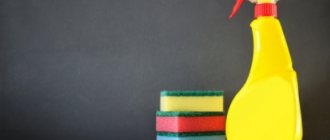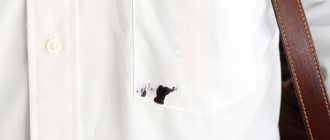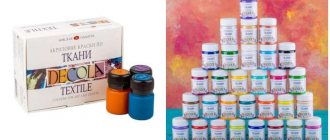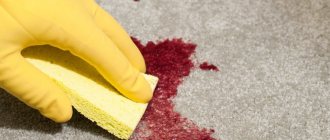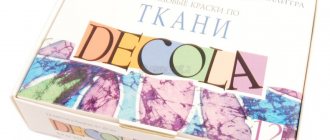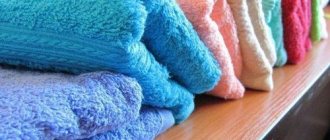While doing creative work, a small child may accidentally stain his or her parents' clothes or things with paint. Artists also often have the problem of old stains that are difficult to remove, especially from white fabrics. To understand how to remove watercolor paints from clothes, you first need to determine the degree of soiling, the type of fabric and suitable cleaning products.
Features of removing watercolor paints
Watercolor paints are water-based and contain various ingredients that help the paints to be absorbed into the fibers of the material. In particular these are:
- dye powder;
- natural adhesives for binding other components;
- a plasticizer to soften the composition, usually honey, glycerin or sugar;
- ox bile – prevents watercolor paint from curling;
- phenol – protects against mold and mildew;
- water as a solvent.
Thanks to the properties of most components, watercolor paint stains are easy to clean, especially if they are fresh.
Types, composition and properties
To understand how to remove paint from fabric or other surfaces, such as carpeting, at home, you need to know as much as possible about gouache:
- It dissolves well in water, just like watercolor.
- It has a thick, dense structure.
- Bright, rich color of various shades, which are achieved due to the special composition of this substance.
- Once applied to the surface, it fades slightly, allowing artists to achieve a matte, natural look to a particular painting.
- To avoid cracking of the dried mass and quickly clean it from the surface, apply gouache in a thin layer.
Kinds:
- artistic;
- fluorescent;
- poster
Gouache composition:
- Its main components are glue and white. Due to the presence of glue, the substance becomes thick, adheres perfectly to the selected base and dries quickly. Whitewash imparts a matte finish and also brings a certain thickness.
- Additional components include: binders (phenols, water, alizarin oil, gum arabic), as well as plasticizers (gum, dextrin, glycerin and others).
- In addition, it contains synthetic mixtures that affect pigments. They make gouache unusually bright.
- It is water-based, but it will not be possible to remove it from things or other surfaces with ordinary liquid.
To remove stains most effectively, before starting this procedure, study what solvents are included in a particular paint and use them during washing.
However, we should not forget about the many folk methods for removing the substance in question from T-shirts, shirts and other materials. The main thing is to follow certain recommendations and tips that will help you achieve maximum results.
How to remove a fresh stain
Since watercolor paints are water-based, you can remove fresh stains without much effort. For this:
- Turn the item inside out.
- Place the contaminated area under running cold water.
- Apply soap suds to the mark and rub with your hands.
- Rinse off any remaining substances with water.
As a rule, such efforts are enough to remove watercolors from fabric.
Methods for removing watercolors from clothes
If more than an hour has passed since watercolor got on your clothes, simply washing in cold water will not help. In this case, you will have to resort to more effective methods.
How to wash
You will only get the effect of processing the product by following certain recommendations:
- For best results, pre-wash the item;
- choose only the processing mode suitable for the type of fabric;
- Scrape off dried paint with a sharp object.
Use improvised or store-bought chemicals to clean stains, following the indicated rules.
Please note that when washing fresh watercolor stains, it is extremely important to use only cold water, otherwise under the influence of high temperatures, the watercolor will be even more absorbed into the fibers of the material.
Features of washing children's clothes
High-quality children's powder copes well with traces of watercolor paints. Using a detergent for washing children's clothes, you definitely will not worry about allergic reactions on your child's skin. To completely remove stains, wash the product 2 times and it will disappear.
Preparing things
If you start removing stains immediately after contamination, the chance of complete cleaning increases. Once the paint has hit the fabric, you need to:
- turn the product inside out;
- rinse it under water until the stain begins to disappear;
- Wipe the blot with laundry soap and wash the item by hand;
- Rinse the product under running water.
Note! The temperature should not be high, since in hot water the paint eats into the fibers of the fabric more strongly. You only need to turn on cold water.
Traditional methods
To remove a watercolor stain from clothing, you don’t have to run to the hardware store for an expensive stain remover. You can wipe away traces of watercolor paint using available substances.
Oil and powder
If the stain is still fresh, clean the item using washing powder mixed with oil. Rub the resulting paste into the stain with a brush. Rinse the treated area thoroughly and wash the item.
Ammonia with salt
Ammonia copes well with various types of stains, including watercolor marks. For the procedure, in addition to ammonia, you will need a saline solution prepared from 1 teaspoon of salt and 1 liter of water. Soak the stain with ammonia and leave for 5 minutes. After this, place the item in salt water and wait another 20 minutes. Remove the item, place it in the washing machine and wash as usual.
Laundry soap
Wet the paint stain with cold water and soap it with laundry soap. Leave the product on the stain for 2-3 hours, regularly moisturizing the soaped area. Rinse off the remaining soap with cold water, and then put the item in the wash.
Soap and soda
The method is suitable for removing stains from cotton materials. Dissolve 1 teaspoon of baking soda and a little shavings of laundry soap in 1 liter of water. Pour the solution into an enamel container and boil. Turn off the heat and place the product in hot water for 10-15 seconds. Extract and look at the result. Repeat the procedure until you achieve the desired effect.
Glycerol
Glycerin not only removes various contaminants, but also softens the fibers, so the method is suitable for cleaning even delicate items. Melt the glycerin in a water bath or in the microwave and apply to the mark. It is more convenient to use a cotton sponge or cloth for this purpose. Leave the glycerin on the surface of the material for 15 minutes and then wash the product.
To prevent glycerin from leaving a greasy stain on the fabric, first mix it with ammonia in a 1:1 ratio.
Hydrogen peroxide and soda
When mixed, the substances form an excellent remedy for combating watercolor stains. Mix baking soda and hydrogen peroxide in equal proportions and add a little hot water. Apply the cleaning mixture to the problem area and leave for 20 minutes to work. Afterwards, rinse off the remaining substances with cold water and wash the item of clothing.
Vinegar
The method is suitable for processing any materials except delicate ones. Before the procedure, warm up some vinegar in the microwave or on the stove. Moisten the stain with hot product and leave for 5 minutes to act. After this, rinse the area with cold water and then wash as usual.
Old and withered: how to cope with a difficult task?
Old stains are those that were placed more than 3 hours ago and have already dried out. The exact curing time depends on the following factors:
- watercolor quality;
- room temperature.
After the dye has dried on the surface of the clothing, removing the stain can damage the structure of the fabric itself and discolor the prints.
For old stains, the following options are suitable:
- using hot vinegar (the acid contained in it corrodes the frozen mass);
- using a recipe based on baking soda, hydrogen peroxide and warm water;
- store-bought stain removers and bleaches.
The stain remover must be selected based on the shade of the clothing. Powder forms of such products require preliminary dilution with water to a paste.
When using a store-bought clothes cleaning product, it is important to follow the instructions for the product.
Use of household chemicals
If you have stain removers or other household chemicals in your arsenal, try using them to remove watercolor stains.
Baby washing powder
Washing powder for children's clothes can be used to treat not only the child's clothes, but also other textiles stained with watercolors. The substances included in the powder actively affect the components of the paints, breaking them down into smaller substances, due to which the paints are successfully removed from the material. Since there are no aggressive substances in the baby powder, watercolor stains on certain fabrics are not removed immediately, but only the second time, so for the best result, repeated washing will be required.
Dishwashing liquid
Suitable for removing fresh stains from clothes. Apply some dishwashing liquid to the stained area and rub in with a sponge or toothbrush. Leave the substance to act for 5-7 minutes and then rinse with water. After such treatment, it is better to wash the product by hand or in a washing machine.
Oxygen stain remover
In the assortment of household chemicals you will find many stain removers that remove watercolor stains well, do not harm the main dye of the fibers and are suitable for processing delicate fabrics.
Amway SA8
It is used both for pre-soaking and for strengthening regular washing powder during washing. Active oxygen components penetrate deep layers of fibers and break down paint pigments. Amway SA8 powder is suitable for almost any material except delicate ones such as wool or silk.
Stork Stop Spot
It is used mainly for washing children's clothing in light shades, but it does a good job of removing stains on other materials. Rub the Stork Stop Spot soap onto the problem area and rinse off with cold water after 20 minutes.
Vanish
This popular stain remover helps clean stains on white and colored clothing. It is produced in the form of a liquid that actively affects various types of contaminants. The instructions on the package will help you determine the optimal processing method and the required amount of product.
"Antipyatin"
Solid soap designed to remove stains does an excellent job of removing watercolor marks on materials. Rub the area previously moistened with cold water with soap and leave for an hour to act. Rinse off the substance with running cold water and completely wash the item by hand or in a machine. If you don’t have the product at hand, replace it with regular laundry soap.
Advice from experienced housewives
In order to achieve an optimal result during the cleaning process without damaging the painted item, you must follow the following tips and recommendations:
- The cleaning process should begin immediately after contamination, so as not to miss the chance to protect the product.
- Try to determine the fabric composition of the clothing and the type of dye that is contaminated with the item, so that you can choose an alternative cleaning product and remove the dye without damaging the fabric.
- Before cleaning dried stains of oil paint, it is necessary to remove its top layer with a sharp object (knife, etc.) and then brush with an iron bristle brush. Only after these procedures can chemicals be used.
- To wash gouache, modern powder or ordinary laundry soap is quite enough.
- When cleaning things from paint, stained items must be on an unpainted surface, otherwise you can damage the table or parquet on which the cleaning is performed.
- When using acetone or gasoline during cleaning, make sure there is good ventilation (open all the windows or the balcony door). In summer, open the windows.
- To wipe off stains using special products, you need to use light pieces of cloth or cotton pads, which should be changed periodically during cleansing.
- If you doubt your abilities and are afraid of ruining your favorite item, take it to a professional dry cleaner, where specialists, using modern technologies, will remove almost any complex stain, giving the item its original appearance.
Now you can easily deal with almost any paint stain at home. But it’s better to be more careful so as not to cause yourself unnecessary trouble and additional washing.
How to remove stains from a white shirt or blouse
If watercolor stains remain on a white blouse or shirt, use more effective treatment methods.
Vinegar and ammonia
The substances enhance each other’s actions, so they work well in removing stains on white clothes. Mix ammonia and vinegar in equal proportions, and soak a cotton swab in the resulting solution. Gently rub the stain from the edges to the center, and then be sure to wash the product.
Boiling
The method is only suitable for removing stains on cotton and linen clothes. For the procedure you will need:
- 1 liter of water;
- laundry soap shavings;
- 1 tbsp. spoon of soda ash;
- 1 teaspoon of ammonia;
- 1 teaspoon of hydrogen peroxide.
Mix the substances in an enamel container and put on fire. Place the product with stains of watercolor paints into the container and boil over low heat for 40 minutes. Carefully remove the item of clothing from the container with tongs and wash with powder or simply rinse thoroughly in plenty of water using conditioner.
Use of solvent
Such products should be used as a last resort and only on suitable materials, but in no case delicate ones. You can use:
- refined gasoline;
- kerosene;
- turpentine;
- solvent for oil paints.
Before the procedure, be sure to check how the substance affects the tissue in an inconspicuous area. If everything is fine, lay the product on a horizontal surface, soak a cloth in the selected substance and rub the stain. Continue rubbing until the mark disappears. After treatment, be sure to wash the item of clothing as usual.
When nothing helps
It also happens that nothing helps to remove a stain from any clothing. What to do in this case? Throwing away your favorite thing? Or is there another way to wash off watercolor paints?
In the most extreme cases, when all methods have already been tried, it is better to take the item to dry cleaning . The salon will help you remove the stain professionally, and if the item is very dear to you, it is better to seek qualified help.
A solution of vinegar and ammonia , which must be soaked into the fabric, can help with the stain Leave the item for half an hour, then rinse with water.
If stains , soak the clothing in a hot solution of table salt. After this, wash the item again.
Also, a little advice before using any of the above methods:
Always try the method on the wrong side first, or preferably on a separate piece of fabric identical in composition and structure, if possible, of course.
And most importantly, if you are engaged in drawing, then choose non-staining and preferably non-white clothes for lessons. Also, don’t neglect protective aprons. We always wear these in the painting studio and give them to guests, since even the most careful people can have small specks of paint on their clothes, which are difficult to even notice right away.
You can also show your imagination and make a patch or applique, or embroidery in the place where the stubborn stain was planted.
If you immediately notice a stain, I recommend that you wash it off immediately, since fresh paint is always easier to remove than dried and stubborn paint.
How to remove old watercolor stains
If watercolor paint has dried on the surface and cannot be removed using simple methods, you should resort to more drastic processing methods.
Dry fragments
This method is suitable for removing stains from dense materials. It’s better not to rush here, but rather wait until the trail dries. Scrape dry watercolor from the surface with a sharp object, such as the blade of scissors or the back of a knife.
Hot salt solution for stains
The method is not suitable for processing synthetic and delicate materials. Dissolve a handful of salt in hot water and keep the product in the solution until the water cools. Afterwards, be sure to wash the item in the usual way.
Toothpaste
Regular toothpaste removes stains from white materials well. Apply some paste to the watercolor mark and scrub with an old toothbrush for a few minutes. After processing, wash the product.
White Spirit
The substance is able to remove even stubborn stains of hair dye, so cleaning the material from watercolors will not be difficult. The product is aggressive, so before use, check whether it will damage the fibers by moistening an inconspicuous area of the material with White alcohol. If nothing happens to the treated area, feel free to wipe the dirt on the product with the substance.
Dry cleaning
Contact a professional dry cleaning service if none of the suggested remedies help. Watercolor stains are considered not very durable, so experts can handle them without much effort.
Recommendations from experts
The following tips will help make your work easier and enhance the effect:
If, after wiping off the stain, stains remain on the fabric, you need to wash the item in a hot soda solution.- Before using a new recipe, it is advisable to test its effect on an inconspicuous area.
- Rubber stains should be wiped off with rubber gloves.
- After treating stains, you should definitely wash the item to remove any residual product from the fabric, eliminate the specific odor and eliminate the possibility of irritation and an allergic reaction from wearing clothes with traces of solvent.
- You can try to scrape off an old stain from dense fabrics in separate fragments.
The best way to deal with a stain is to prevent it from happening. For children involved in creative work, a waterproof apron and special sleeves may be useful.
Features of removing stains from different materials
Of course, each method indicated should be used only in accordance with the type of material from which the soiled item is sewn.
Cotton
Cotton is the easiest material to remove watercolor stains from. To begin with, try more friendly substances, for example, laundry soap, industrial products or hot vinegar. For white items, you can use a more radical method - boiling.
Natural silk
Delicate material that requires special treatment. To remove stains from silk, you can safely use laundry soap, leaving the foam on the problem area for 20 minutes, as well as denatured alcohol. Preheat the alcohol in a water bath. Soak a sponge in the substance and gently wipe the stain from the edges to the center. After drying, sprinkle the treated area with talcum powder without impurities and oils.
Synthetics
Under no circumstances should synthetics be boiled or even washed in hot water. For processing, use only cool water. Traces of watercolor paint can be easily removed from synthetic materials using ammonia and soaking the product in a salt solution.
Wool
Such a delicate material as wool does not tolerate exposure to aggressive substances. The best product for processing wool products is laundry soap. To keep the fibers soft, use soap suds and cold boiled water for cleaning.
Knitwear
Use eucalyptus oil to remove paint stains from knitted fabrics. Moisten a cotton swab with ether and carefully wipe the mark from the edges to the center. Greasy stains can be cleaned with acetone or alcohol. After processing, place the product in the washing machine.
Jeans
You can remove watercolor paint from thick denim by scraping the surface with the back of a knife. To remove fresh traces of watercolor, laundry soap or stain remover is perfect.
How to remove traces of face painting?
Aquagyrm is very similar in composition to watercolor paints, therefore it is removed from materials in the same way as watercolor marks. To remove face painting stains, use laundry soap, rubbing the contaminated area with the substance and rinsing with cold water after 20–25 minutes. If the pigment has penetrated into the deep layers of the fibers, use a stain remover or glycerin with ammonia to clean.
Washing watercolor paints is not difficult if you follow certain processing methods depending on the age of the stains and the type of material. To begin with, try treating the product with gentle means at hand, and resort to more aggressive substances or dry cleaning only in extreme cases.
